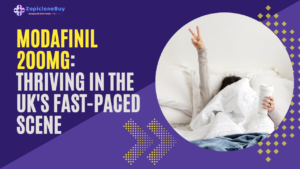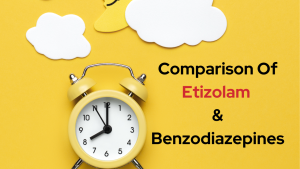While Zopiclone and Melatonin are instrumental in treating insomnia, Zopiclone has established itself superior in terms of its efficacy, availability, and legal authority. Though an effective treatment for insomnia, Melatonin does not have faster mechanism of action as that of Zopiclone. Additionally, Melatonin, because of its legal viability, is not taken seriously even with its wide range of uses. Owing to various factors, Zopiclone has universally been accepted as a better treatment of insomnia than Melatonin. Let’s dive deeper to know more. .
What exactly are these two drugs?
In simple terms, both Zopiclone and Melatonin are sedatives, i.e. they enable people with disturbed sleep cycles to relax and promote sleep. Zopiclone is a nonbenzodiazepine classified as a cyclopyrrolone. It deals extensively with insomnia and its possible outcomes. Melatonin is an over-the-counter drug used primarily as a dietary supplement for insomnia and other aspects of your health. It is used for other purposes, such as dealing with jet lag and adjusting your sleep cycle.
How different are they?
Zopiclone works by stimulating the benzodiazepine receptors in the brain. It binds to different sites on the GABAA receptors in the brain. These receptors strongly control inhibitory signals in the central nervous system. The resulting binding leads to enhancement of GABA actions, thus helping produce its sedative, hypnotic and myorelaxive effects.
Melatonin works as a free radical scavenger within the mitochondrial cells of the body, promoting the expression of antioxidant enzymes through the melatonin receptors. When used several hours before sleep, Melatonin enables fast-forwarding the circadian clock to enable early sleep and awakening. In short, it does not directly help in the treatment of insomnia but aids in modulating the sleep clock.
Which one works better?
Zopiclone usually is taken just before sleeping. Being a moderately strong sedative, its effect takes 1 hour to kick in, after which the subject can enjoy 7-8 hours of uninterrupted sleep. Apart from managing the sleep issues, Zopiclone takes care of the issues of midnight awakenings followed by hours of unrest and early morning awakening followed by an uncomfortable day. This property of sedation enables it to be used in after-injury patients along with people with Alzheimer. It has a half-life of approximately 6-10 hours, after which it gets flushed out by the system.
Melatonin has to be taken an hour or two before bedtime to enable it to shift the circadian clock as per our requirement. Taking Melatonin at the right time is crucial for its effectiveness. Using it just before sleep will fast forward the circadian clock leading the subject to feel sleepy in the daytime. Melatonin, effectively reducing the effects of jet lag or adjusting the sleep cycles, enables promoting healthy sleep. But it does not help in solving the problems of nighttime or early morning awakening. Additionally, it has a shorter half-life of 5-6 hours, making it stay in the system for a much lesser time, thereby affecting its performance.
Dosage variance
Zopiclone has a definite strength of 3.5mg or 7mg with dosage instructions to use one tablet daily. The dose should not exceed twice or thrice weekly and should be taken just before bedtime. The strength of the dose is strictly determined according to the severity of your conditions and the treatment plan of your practitioner. It has to be followed diligently for 2-4 weeks and carefully tapered down after completion instead of abruptly discontinuing it in between to avoid the possibility of drug addiction and reduce the effects of withdrawal symptoms.
Melatonin, in comparison, is claimed to be effective in several ways but without any medical research or studies to prove its efficacy. The dosage varies as per the practitioner without requiring any medical authorization. It does not require a prescription or a guideline for use. The dosage is divided into varying degrees of 0.3 mg-5mg for sleep disorders, 0.5-3mg for night sleep disturbances, 2.5-5mg for blood pressure-related insomnia and 8-10mg for other conditions.
Advantages and Disadvantages
Apart from successfully treating insomnia, Melatonin can be used in patients with post-traumatic or post-surgical pain owing to its sedative, hypnotic, and myorelaxant properties. It has been used to enable sleep in severe cases of Alzheimer along with treating anxiety caused due to insomnia. It is not advised in the pediatric or geriatric population because of its tendency of causing withdrawal symptoms.
Though proclaimed to have fewer side effects with the potential of being successfully used in children and elderly people, Melatonin has a lot on its plate without any research or evidence to justify its use. It has been proclaimed as being useful in endometriosis, cancer patients and good for eye health. The same has also even been hailed as a wonder-drug enabling athletic performance and weight loss benefits, but no actual reports or group tests have been legally authorized to prove its credits so far.
In a nutshell
A medicine’s effectiveness depends on its extensive research, studies and trials leading to legal approval of the drug, which makes it even safer to use. Zopiclone, with all its effects, doses, strengths and side effects, has been FDA approved. Melatonin, with all its advantages, hasn’t been yet FDA approved. The FDA approval of a drug makes it evident that the drug has gone through a series of laboratory, clinical and human testing. It essentially proves the point that the benefits of the medications outweigh the risks associated with them. This makes Zopiclone a safer and clinically-approved drug for complex disorders-a feature yet to be said for Melatonin. While Zopiclone emerges as the drug of choice for insomnia, Melatonin remains a power pill important in many conditions yet without FDA approval.





